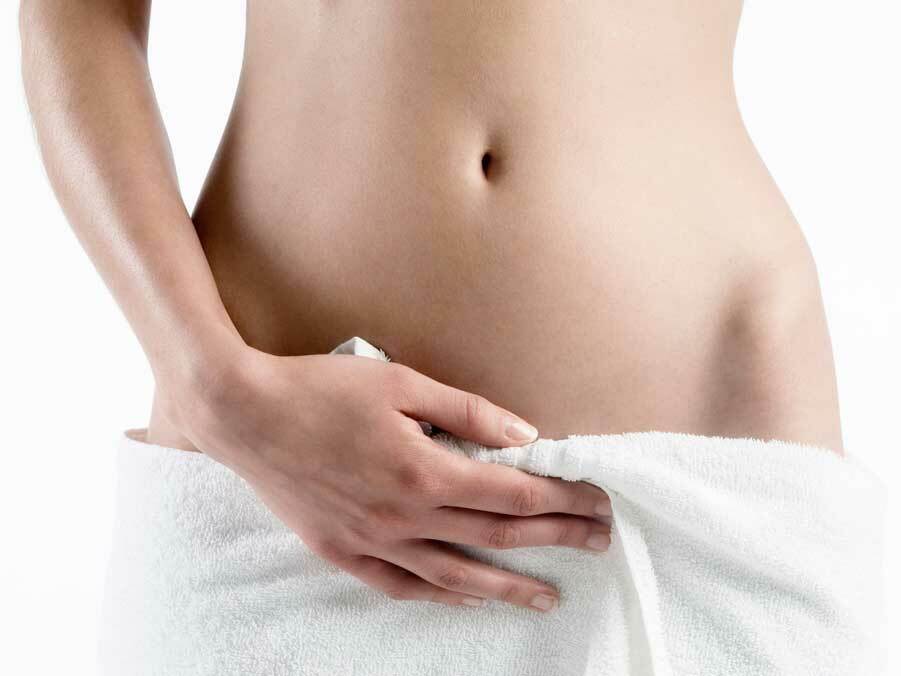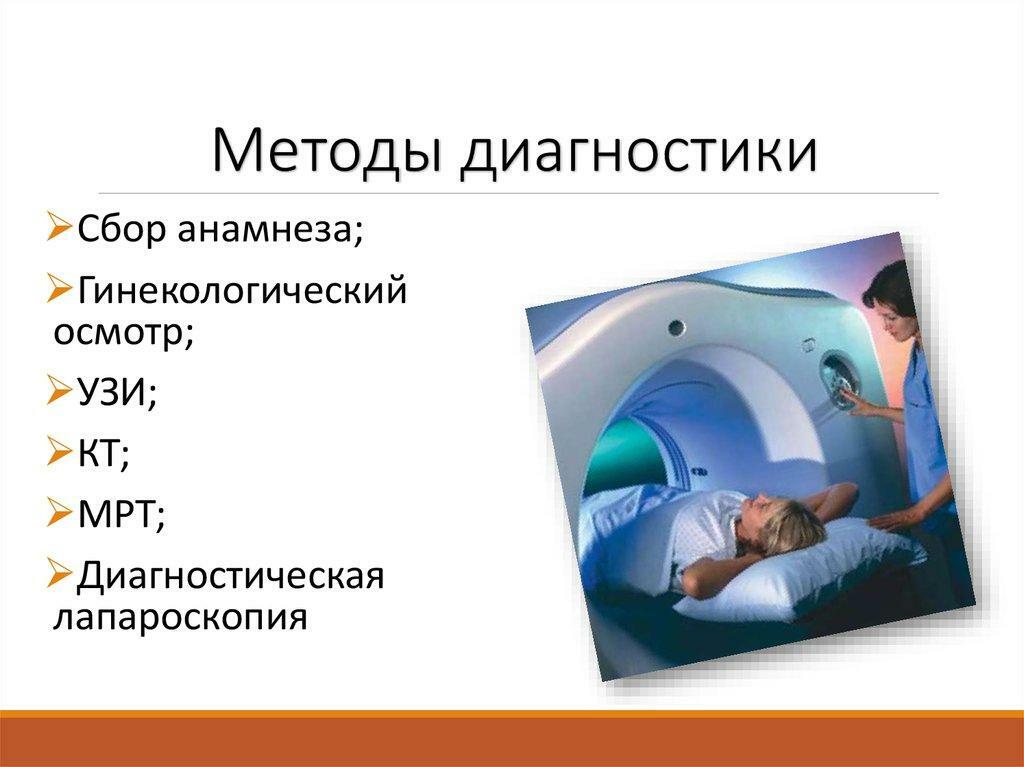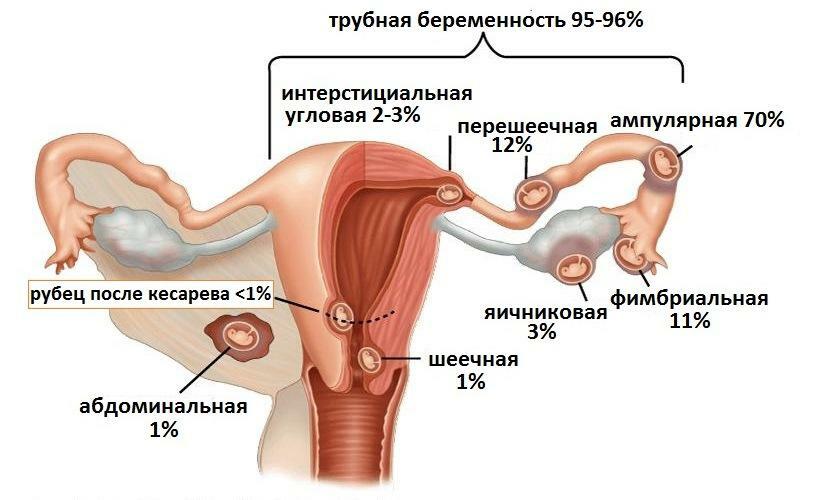Pain syndrome worries many women during menstruation. The most unpleasant sensations occur in the lower abdomen. The reason - the contraction of the muscular layer of the uterus, which occurs during this period. However, some types of pain indicate gynecological diseases. And they need to be able to identify for timely treatment.
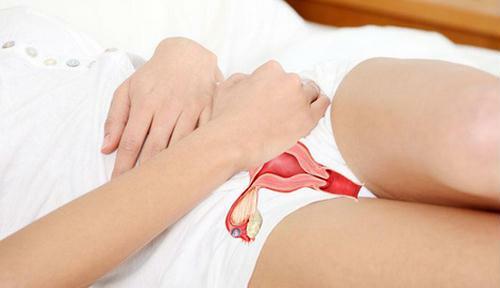
Why does it hurt the lower abdomen
for a month? The content of the material
- 1 The causes of menstrual pain
- 1.1 Video - Painful menstruation
- 2 Cystitis
- 2.1 Video - How to treat cystitis at home
- 3 Inflammation of the appendages
- 4 Endometriosis
- 4.1 Video - How to treat endometriosis at home
- 5 Ovarian cyst
- 6 Myoma of the uterus
- 6.1 Video - Hysteromyoma: signs, symptoms, treatment
- 7 Conclusion
Causes of menstrual pains
Pain is the body's signal about atrailing changes and violations. It can not be ignored, because it is a symptom of reproductive and urinary system diseases. However, pain sensations are not a cause for concern in all cases.
NOTICE!Acute pain is a serious reason to call an ambulance. It can occur due to inflammation of the cyst or appendicitis, even during menstruation. In this case, you must refrain from taking any medications and wait for the doctor to arrive. Self-treatment is dangerous.
| Pain type | Characteristic | Reasons for |
|---|---|---|
| Drawing | Occurs in muscles during menstruation. Also may appear within a week or 1-2 days before the monthly | Strong uterine contractions. Drawing pain most often occurs in nulliparous girls. Passes after pregnancy |
| Aching | Spreads on the lower part of the abdominal cavity. Does not pass for a long time. Can give back | Hypersensitivity of nerve endings. Incorrect position of the uterus( bend) and its strong increase during the monthly |
| Stupid | Reminiscent of a feeling of heaviness in the abdomen. It can also appear on the first day of menstruation. Passes within 24 hours | Appears due to increased physical activity |
| Cramping | Moderate cramping pain is considered normal during menstruation. Has a paroxysmal character. However, you need to see a doctor if it is unbearable and does not last for a long time. | Intensive reduction in the uterus, fallopian tubes, ureters, bladder, intestine. Strong cramping pain indicates abnormalities in the reproductive or urinary system |
| Acute | Severe and prolonged pain. Strengthens when walking. It can become something more, then less intense. A distinctive feature - with a sharp increase in pain, you want to bend or sit down. Is a symptom of disorders and diseases of the reproductive system | Acute pain can be caused by dysmenorrhea( pronounced abdominal pain at the beginning of the period).It takes 1-2 days. Also, the cause of discomfort can be infectious and inflammatory diseases. In this case, pain is observed throughout the entire |
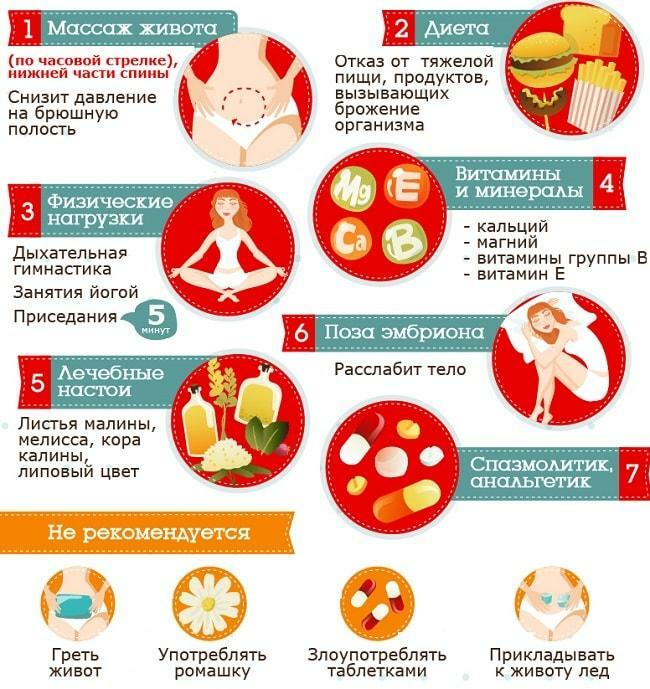
cycle. How to reduce pain with monthly
NOTICE!Determine the exact cause of pain during menstruation can only specialist. However, for this you need to know not only the nature of pain, but also localization.
Video - Painful menstruation
Cystitis
Cystitis often worsens during menstruation. There are sharp and pulling pains in the lower abdomen, which intensify with urination. There may also be a feeling of heaviness in the lower abdomen and a strong aching pain in the lower back. It should be noted that cystitis also has other characteristic features that can be easily recognized:
- burning and itching in the vagina;
- severe redness and irritation;
- elevated body temperature;
- headaches and dizziness.
NOTICE!Exacerbation during menstruation is due to the fact that, due to the outflow of blood, the spread of infection occurs many times faster. Also, menstrual blood becomes a good environment for the development of bacteria with neglect of hygiene rules.
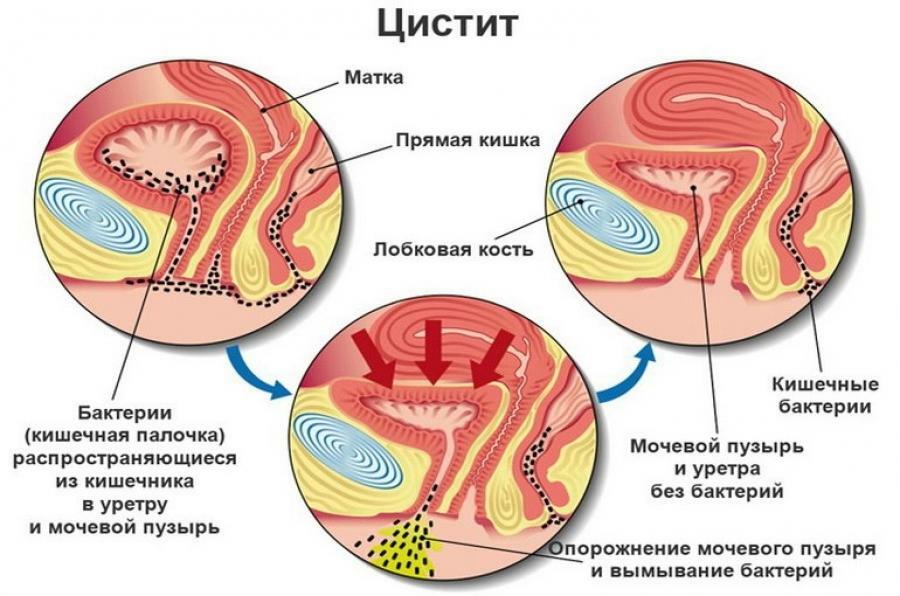
What is cystitis
It is easy to remove the symptoms of cystitis, but treatment can take a long time. If you let the disease into its own right, it can grow into a chronic form. Most commonly, a general urine test and ultrasound of the urogenital organs is prescribed to make an accurate diagnosis. Cystitis is treated with antibacterial drugs. Additionally, a diet is prescribed for the duration of treatment, excluding acute and fatty foods from the diet.
NOTICE!During treatment, you must stop taking a bath and wash yourself only in the shower, otherwise the cystitis may become worse. The water temperature should not be more than 38-39 degrees.
Video - How to treat cystitis at home
Inflammation of appendages
Pain sensations are intense in nature. When inflammation of the appendages there is an acute, pulling or aching pain. Begins to worry about 1-2 days before the onset of menstruation and stops on the second day of menstruation. In some cases, it leaves after the end of the period. There are also other symptoms:
- itching and burning in the vagina;
- elevated body temperature( up to 39 degrees);
- abundant or, conversely, scanty monthly;
- nausea;
- pain and discomfort when urinating.
NOTICE!Inflammation of the appendages is an infectious and inflammatory disease. It occurs due to hypothermia, colds and stresses. It can also develop against the background of sexually transmitted infections.
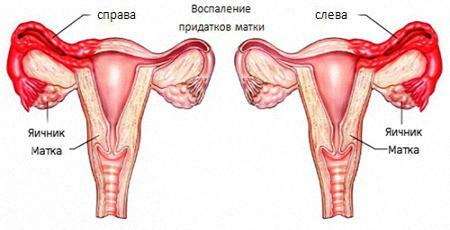
Schematic depiction of inflammation of the appendages
Pain localizes in the lower abdomen from the left and right side. It manifests itself in the acute form of inflammation of the appendages. If you ignore the symptoms, the disease will eventually become chronic.
However, the most dangerous is considered a hidden form. In this case, there are no signs of disease. Then the inflammation of the appendages is diagnosed by ultrasound and laboratory tests.
Treatment is based on antibiotics aimed at destroying pathogens. To enhance the effect of appoint candles. You also need to follow a doctor's prescribed diet and lead a healthy lifestyle.
Endometriosis
Intolerable pain and copious discharge are the main signs of endometriosis. Scanty periods during this disease are extremely rare. A few days before menstruation, there is pain in the lower abdomen, which gives back. In addition, brown discharge may appear. Allocate other signs of the disease:
- irregular cycle;
- large delays;
- nausea;
- vomiting;
- problems with urination;
- constipation.
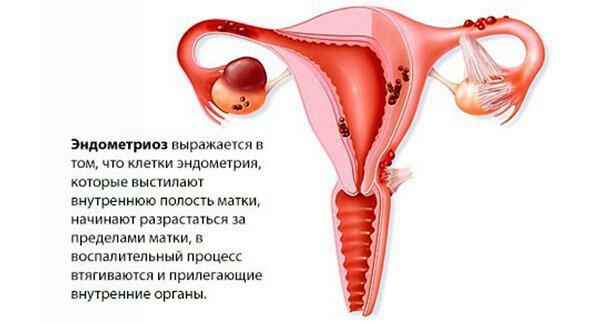
What is endometriosis
During monthly pain become strong and permanent. In general, they are cramped or aching in nature, but they still have intensity. This reaction is due to excessive rejection of the endometrium and damage to the blood vessels.
NOTICE!Endometriosis is rare in women taking hormonal drugs.
An accurate diagnosis is made on the basis of studies. Endometriosis is diagnosed with ultrasound, computed tomography and laparoscopy. After the examination, you can determine the method of treatment of the disease. There are two methods:
- hormonal treatment;
- surgical intervention.
NOTICE!Endometriosis passes after pregnancy and childbirth. However, during this disease it is very difficult to get pregnant. If this happens, doctors recommend not to abandon the child. However, immediately it is necessary to exclude ectopic pregnancy.
Video - How to treat endometriosis at home
Ovarian cyst
The occurrence of acute and unbearable pain in the ovaries during menstruation is the main sign of the presence of a cyst. Pain sensations can be permanent and periodic. May occur in any period of the cycle, but worsen during menstruation and ovulation.
The localization of pain depends on the place of origin of the cyst. Both the right and left ovary can hurt, and both can be ill. Tingling and rippling can also be felt. But there are other symptoms:
- large delays monthly;
- pain during intercourse;
- disorders in the urinary system( painful urination);
- abdominal enlargement and asymmetry;
- hirsutism( growth of facial hair).
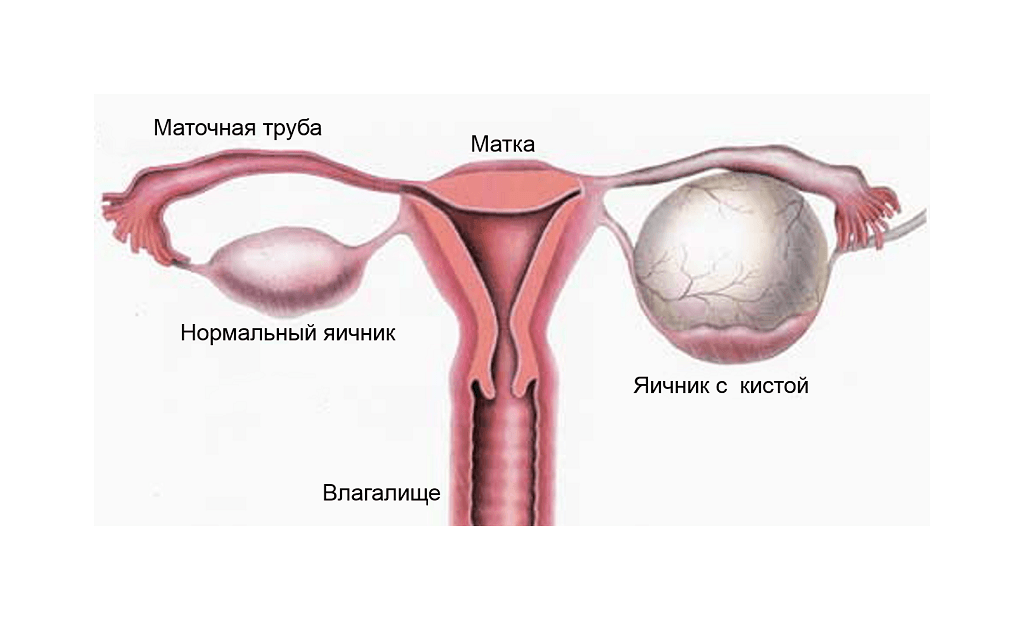
Schematic representation of ovarian cyst
NOTICE!Danger is not the cyst itself, but the torsion of its legs or rupture. Therefore, it is important to identify the cyst in time and begin its treatment.
Ovarian cyst is easily detected on ultrasound. Small formations can be cured with the help of hormonal drugs. Large and numerous cysts are removed surgically. To avoid surgery, it is necessary to identify the cyst at an early stage, until complications have begun. Medications are not treated:
- numerous formations;
- large cysts( 5-10 cm);
- cysts detected shortly before menopause;
- cysts that appeared during menopause.
Myoma of the uterus
During this disease, pain lasts until the last day of menstruation. As a rule, the intensity of each time only increases. At the initial stage, there are pulling and aching pains, which, when complicating, acquire an acute cramping character.

Classification of uterine myomas
Pain is felt not only in the lower abdomen, but also in the lower back. It can also spread all over the back before the monthly and in the early days. In addition, significantly increases the sensitivity of the breast. Also, when uterine myomas are observed:
- dark brown discharge before, during and after menstruation;
- cycle reduction;
- significant increase in the duration of menstruation up to several weeks;
- heavy bleeding( less meager);
- presence of clots in secretions.
NOTICE!A common cause of myoma occurrence is hormonal failure. The increased production of estrogens, female sex hormones, leads to the formation of a tumor.
In some cases it is possible to notice myoma during gynecological examination. It is also detected using ultrasound, hysteroscopy, laparoscopy, endometrial biopsy and laboratory studies. It is treated by medicamentous way. The course of taking hormonal drugs is prescribed. However, to combat large tumors, surgery may be necessary.
Video - Hysteromyoma: signs, symptoms, treatment
Conclusion
Mild pain at the beginning of menstruation is normal. As a rule, they pass during the first two days of the cycle. But acute pain syndrome is a cause for concern. Especially if there are additional symptoms. In this case, you need to see a doctor to exclude the presence of infectious-inflammatory and chronic diseases.

